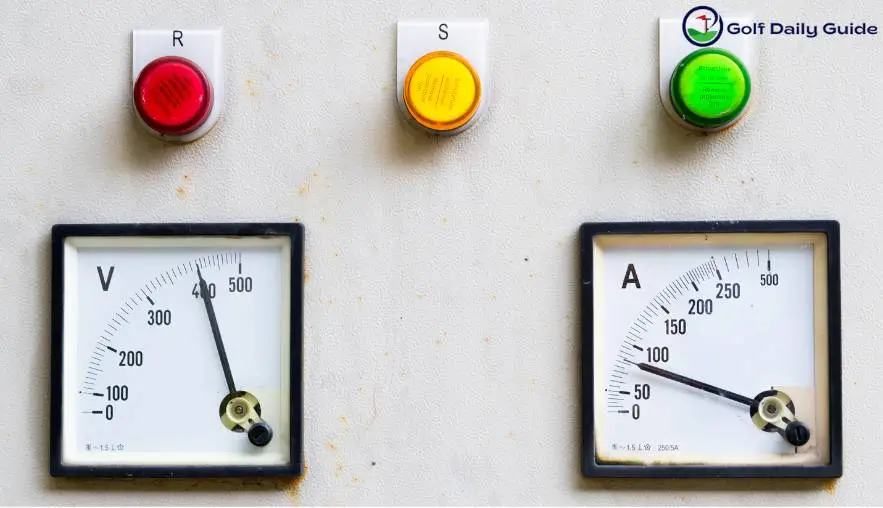Are you looking to enhance your golfing experience with a new golf cart, but unsure of the difference between golf cart 36 volt vs 48 volt options? Making the right choice can significantly affect your game and overall enjoyment of the course.
Understanding the power and performance differences between 36-volt and 48-volt golf carts is crucial for any golfer looking to upgrade their equipment.
In this blog, we’ll explore the key differences between these two options, equipping you with the knowledge you need to make an informed decision.
Whether you’re an experienced golfer or just starting out, having the right golf cart can make all the difference in your game. Let’s explore the world of golf carts and find the best fit for your needs.
what is Golf Carts
Golf carts have become a common sight on golf courses, but their usefulness extends far beyond the fairways.
These small vehicles have gained popularity for various purposes, from transportation in communities and commercial settings to recreational use in outdoor events. Let’s delve into what golf carts are and their diverse applications.
At their core, golf carts are compact, motorized vehicles designed initially for transporting golfers and their equipment around the course.
They are typically electric or gas-powered, with seating for two to four passengers. The design is simple yet functional, featuring a flat platform for golf bags and a steering wheel for easy maneuvering around the greens.
Beyond the golf course, golf carts have found their way into various settings due to their versatility.
In residential communities and commercial properties, they serve as convenient transportation for residents, workers, and goods within the premises.
Their quiet operation and zero emissions make them an eco-friendly choice for short-distance travel.
In addition to practical use, golf carts are also popular for recreational purposes. They are a common sight at outdoor events, campgrounds, and parks, offering a fun and convenient way to explore the surroundings.
Many people also customize their golf carts, adding features like stereo systems, custom paint jobs, and off-road tires to suit their personal style and preferences.
For younger adults in the 18-40 age group, golf carts offer a unique blend of practicality and leisure.
Whether it’s cruising around the neighborhood, exploring outdoor venues, or simply enjoying a round of golf with friends, these versatile vehicles provide a fun and eco-friendly mode of transportation.
What is Voltage?
Voltage is a fundamental concept in the world of electricity, and understanding it is crucial for anyone who wants to grasp the workings of electrical systems.
So, what exactly is voltage? Let’s dive into this electrifying topic and shed some light on what voltage is all about.At its core, voltage can be defined as the potential difference in electric charge between two points.
In simpler terms, it’s the force that pushes electric charges along a conductor. Just like water flows from a higher point to a lower point due to gravity, electric charges flow from a point of higher voltage to a point of lower voltage.
To put it into perspective, think of voltage as the pressure in a water pipe. The higher the pressure difference between two points, the faster the water will flow.
Similarly, the higher the voltage difference between two points, the stronger the push on electric charges, leading to a higher flow of electricity.
In the world of electronics, voltage is measured in volts, named after the Italian physicist Alessandro Volta, the inventor of the electric battery.
Volts are the unit used to quantify the potential difference in electric charge. When you see a label that says “10V” on a battery or an electrical device, it’s indicating the voltage at which it operates.
Understanding voltage is essential for anyone working with electrical devices or systems. It’s like understanding the pressure in a water pipe for a plumber – it’s the foundation of their work.
In the same way, electricians, engineers, and anyone dealing with electronics need to have a good grasp of voltage to ensure the safe and efficient operation of electrical systems.

Importance of Voltage in Golf Carts
There are many uses for golf carts, including transportation in gated communities, industrial settings, and even recreational uses.
One of the key factors that determine the performance of a golf cart is the voltage of its battery system. When it comes to golf cart batteries, the debate between Golf cart 36 volt vs 48 volts is a hot topic among enthusiasts and users alike.
Voltage plays a crucial role in the performance of a golf cart. The voltage of a golf cart battery system determines the power and speed of the vehicle.
A higher voltage generally means more power, which translates to better acceleration and overall performance.
On the other hand, a lower voltage may result in slower speeds and reduced power, especially when traversing hilly terrain or carrying heavy loads.
For golf cart users, understanding the importance of voltage is essential in making an informed decision when purchasing or upgrading their vehicles.
The difference between a 36-volt and a 48-volt golf cart can significantly impact the user experience and the cart’s capabilities.
When comparing a 36-volt golf cart to a 48-volt model, the most noticeable difference is the power and speed.
A 48-volt golf cart generally offers better acceleration and higher top speeds compared to a 36-volt model. This can be especially important for users who require their golf carts to navigate demanding terrains or transport heavy loads.
Additionally, the voltage of a golf cart also affects its overall efficiency and range. A 48-volt golf cart is often more energy-efficient compared to a 36-volt model, allowing for longer operating times between charges.
This can be a significant advantage, especially for users who rely on their golf carts for extended periods or cover long distances.
Another crucial aspect affected by voltage is the torque and climbing ability of the golf cart. A 48-volt system generally provides more torque, making it easier for the cart to climb inclines and navigate challenging terrains.
This can be a deciding factor for users who require their golf carts to perform in diverse environments.
Difference Between 36-Volt and 48-Volt Golf Carts
The Difference Between 36-Volt and 48-Volt Golf CartsAre you in the market for a golf cart and wondering what the difference between 36 Volt and 48 Volt is?
The purpose of this article is to help you make an informed decision about golf carts.
First and foremost, let’s talk about the power aspect. Six 6-volt batteries power a 36-volt golf cart, while six 8-volt batteries power a 48-volt golf cart
48-volt golf carts provide more power than 36-volt golf carts, resulting in improved speed and performance.
When it comes to battery life, the 48-volt golf cart has the upper hand. This cart’s higher voltage allows it to travel further on a single charge, allowing extended usage without frequent recharging.
On the other hand, the 36-volt golf cart may need more frequent recharging due to its lower voltage capacity.
Now, let’s discuss the overall performance. For hilly terrain and demanding courses, the 48-volt golf cart offers better hill-climbing capabilities and acceleration.
36-volt golf carts may not accelerate as quickly as 48-volt golf carts on steeper inclines.
In terms of maintenance, both options require regular care and upkeep. However, the 48-volt golf cart’s higher voltage system may require more attention to ensure the batteries are functioning optimally.
Conversely, the 36-volt golf cart’s lower voltage system may be slightly less demanding in terms of maintenance.
When it comes to cost, 36-volt golf carts are generally more affordable upfront compared to their 48-volt counterparts.
However, it’s essential to consider the long-term benefits and performance differences when making the investment.
Advantages and Disadvantages of 36 volt vs 48 volt Golf Carts
Are you in the market for a golf cart and trying to decide between 36 Volt and 48 Volt models? Look no further! We’ll walk you through the advantages and disadvantages of each in this comprehensive guide.
Advantages of 36 Volt Golf Carts
1. Cost-Effective: It is generally more affordable to buy 36 volt golf carts than 48 volt golf carts.
2. Lower Maintenance: With fewer batteries to maintain, 36 volt golf carts can be easier and less expensive to upkeep.
3. Lighter Weight:Longer battery life and energy efficiency are possible with a 36 volt golf cart’s lighter battery pack.
Disadvantages of 36 Volt Golf Carts
1. Limited Power: It may be difficult for 36 volt golf carts to handle hilly terrain or when carrying heavy loads.
2. Slower Speed: Due to the lower voltage, 36 volt golf carts may have a slower maximum speed compared to 48 volt models.
Advantages of 48 Volt Golf Carts
1. Enhanced Power: Off-road and challenging golf courses require 48 volt golf carts because they can handle more demanding terrain.
2. Faster Speed: For those who prefer a more exhilarating ride, 48 volt golf carts can reach higher speeds.
3. Better Performance: The additional power provided by a 48 volt system can result in improved acceleration and overall performance.
Disadvantages of 48 Volt Golf Carts:
1. Higher Cost: 48 volt golf carts are typically more expensive upfront, which may not be ideal for budget-conscious buyers.
2. Increased Maintenance: With more batteries to maintain, 48 volt golf carts may require more frequent and costly upkeep.
Factors to Consider Before Choosing Between 36-Volt and 48-Volt Golf Carts
One of the most significant differences between a 36-volt and a 48-volt golf cart is the battery life and power output.
For hilly terrain or heavy loads, 48-volt systems provide more power and torque.
On the other hand, a 36-volt system may be sufficient for flat terrains and lighter usage. Consider your typical golf cart usage and terrain when evaluating the power needs.
Charging Time
Another important factor to consider is the charging time for the batteries. A 48-volt golf cart may require more time to fully charge compared to a 36-volt cart.
If you value quick turnaround times between uses, this could be a crucial factor to take into consideration.
Cost
The cost of a 48-volt golf cart and its maintenance may be higher than that of a 36-volt cart.
However, the increased power and performance may justify the higher initial investment for some users. Evaluate your budget and long-term cost implications when making your decision.
Compatibility and Availability
Consider the compatibility of accessories and replacement parts with your chosen voltage option. Additionally, assess the availability of charging stations and support services for the specific voltage system you opt for.
Personal Preference and Comfort
You should also consider your own preferences and comfort level with the golf cart’s performance.
Test-driving both options and gathering feedback from other users can provide valuable insights.
Frequently Asked Questions
What are the differences between a 36-volt and a 48-volt golf cart?
Voltage disparity: 36-volt carts offer lower power than 48-volt ones. This affects acceleration, speed, and battery size, influencing overall performance and functionality.
How does the voltage affect the performance and speed of a golf cart?
Voltage dictates motor power, impacting acceleration and speed. Higher voltage (48V) carts generally perform better, ideal for hilly terrains or heavy loads.
What factors should be considered when choosing between a 36-volt and a 48-volt golf cart?
Consider terrain, course length, load capacity, budget, and maintenance costs. While 48V carts offer superior performance, they may entail higher initial and upkeep expenses.
Last Note
In conclusion, choosing between a 36-volt and a 48-volt golf cart ultimately depends on your specific needs and preferences.
When it comes to hilly courses, the 48-volt option offers more power and better performance.
Consider factors such as terrain, distance, and frequency of use when making your decision. Both options have their advantages, so it’s important to weigh them carefully before making a choice.
You should choose a golf cart that meets your individual needs and enhances your golfing experience.
Ultimately, the right golf cart for you is the one that meets your individual requirements and enhances your overall golfing experience. Keep these considerations in mind when deciding which voltage is best suited for your needs.












